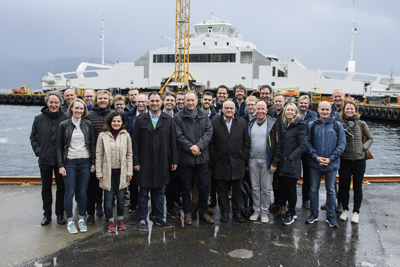The EU project TrAM was officially kicked off in September 2018. It marked the start of a journey towards the world´s first zero emission fast ferry, built through modular production methods.
Four years from now, workers commuting between Stavanger and neighbouring islands will travel silently and emission free by sea. But the legacy of TrAM is much more than a unique zero emission vessel. Through modularization the project will also revolutionize Norwegian production of zero emission vessels.
Funded by the EU
The TrAM project was awarded funding through EU´s Horizon 2020 programme in January 2018. It was a result of years of hard work and successful cooperation between Rogaland County Council and NCE Maritime CleanTech. Together they developed a strong application and hand-picked participants for a strong consortium with actors from both the industry and leading research institutions.
– We are very eager to get started to develop this zero-emission passenger vessel, which will be in operation outside Stavanger from 2022. The project gathers leading European expertise within ship building, propulsion and zero emission technology. We also have several world-leading partners from the research industry, she says.
– The main purpose of the project is to develop new modular manufacturing methods that will reduce the vessel cost by 30 percent. This will make electric-powered high-speed vessel more competitive in terms of both cost and the environment, Hege Økland adds.
High climate and environmental ambitions
The operator of the local route is Kolumbus, a public transport company owned by Rogaland County Council. Kolumbus has ambitious environmental targets for the public transport sector and look forward to cooperating with local and international technology and know-how providers.
– We have people here from Greece, Germany, Scotland, Norway, Belgium and the UK. We have people from the industry and we have bureaucrats like me, in the same room. We need to meet each other, have discussions and clarifications and find out how we are going to do this, Project Manager in the County Council Iver-Jan Leren says.
Will learn from aviation and automotive industries
One of the research institutions involved in the project is Fraunhofer Institute for Industrial Engineering (IAO). The company has developed production methods for large companies such as Volkswagen, Audi and Boeing.
– The project is really interesting for us, because we can adapt methodologies we have used in the aviation and automotive industries and transfer them to the maritime industry, Dr Ing Christoph Jürgenhake of Fraunhofer IAO says.
He explains that their approach to the project is completely different to that of a mechanical designer. The latter would normally start with the shape, while Fraunhofer will start with the functionality and try to modularize the ship to adapt the production technologies.
– What the maritime industry can learn is how to modularize their product structure and architecture. In the maritime industry most ships are built as one-offs, in contrast to planes and cars which are built in larger volumes. Much more effort is put into developing the parts, he says.
“Hydro-powered” fast ferry
The route between Stavanger and the suburb Hommersåk has been operated by local ferries for close to 100 years. For many people the route is an institution, and in only four years’ time the passengers will be among the first in the world to commute via a zero emission fast ferry powered solely by hydro power charged batteries.
– The vessel developed in the TrAM project will be in route from January 2022 and it will be zero emission. The project will be an important enabler for the industry to reduce their costs in the future. I am 100 per cent sure, Iver-Jan Leren of Rogaland City Council says.

